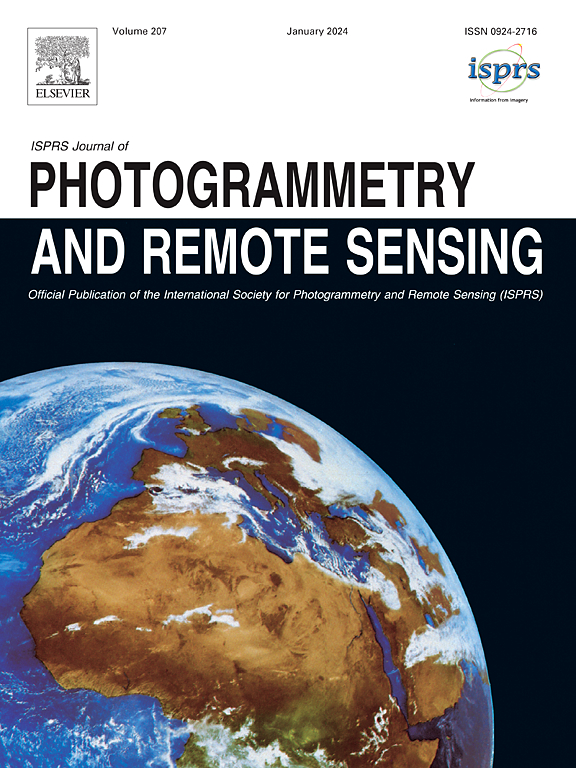Advancing mangrove species mapping: An innovative approach using Google Earth images and a U-shaped network for individual-level Sonneratia apetala detection
IF 12.2
1区 地球科学
Q1 GEOGRAPHY, PHYSICAL
ISPRS Journal of Photogrammetry and Remote Sensing
Pub Date : 2024-11-07
DOI:10.1016/j.isprsjprs.2024.10.016
引用次数: 0
Abstract
The exotic mangrove species Sonneratia apetala has been colonizing coastal China for several decades, sparking attention and debates from the public and policy-makers about its reproduction, dispersal, and spread. Existing local-scale studies have relied on fine but expensive data sources to map mangrove species, limiting their applicability for detecting S. apetala in large areas due to cost constraints. A previous study utilized freely available Sentinel-2 images to construct a 10-m-resolution S. apetala map in China but did not capture small clusters of S. apetala due to resolution limitations. To precisely detect S. apetala in coastal China, we proposed an approach that integrates freely accessible submeter-resolution Google Earth images to control expenses, a 10-m-resolution S. apetala map to retrieve well-distributed samples, and several U-shaped networks to capture S. apetala in the form of clusters and individuals. Comparisons revealed that the lite U-squared network was most suitable for detecting S. apetala among the five U-shaped networks. The resulting map achieved an overall accuracy of 98.2 % using testing samples and an accuracy of 91.0 % using field sample plots. Statistics indicated that the total area covered by S. apetala in China was 4000.4 ha in 2022, which was 33.4 % greater than that of the 10-m-resolution map. The excessive area suggested the presence of a large number of small clusters beyond the discrimination capacity of medium-resolution images. Furthermore, the mechanism of the approach was interpreted using an example-based method that altered image color, shape, orientation, and textures. Comparisons showed that textures were the key feature for identifying S. apetala based on submeter-resolution Google Earth images. The detection accuracy rapidly decreased with the blurring of textures, and images at zoom levels of 20, 19, and 18 were applicable to the trained network. Utilizing the first individual-level map, we estimated the number of mature S. apetala trees to be approximately 2.35 million with a 95 % confidence interval between 2.30 and 2.40 million, providing a basis for managing this exotic mangrove species. This study deepens existing research on S. apetala by providing an approach with a clear mechanism, an individual-level distribution with a much larger area, and an estimation of the number of mature trees. This study advances mangrove species mapping by combining the advantages of freely accessible medium- and high-resolution images: the former provides abundant spectral information to integrate discrete local-scale maps to generate a large-scale map, while the latter offers textural information from submeter-resolution Google Earth images to detect mangrove species in detail.
推进红树林物种绘图:利用谷歌地球图像和 U 型网络进行个体级 Sonneratia apetala 检测的创新方法
数十年来,外来红树林物种Sonneratia apetala一直在中国沿海定殖,引发了公众和政策制定者对其繁殖、扩散和蔓延的关注和争论。现有的地方尺度研究依赖于精细但昂贵的数据源来绘制红树林物种图谱,由于成本限制,这些研究在大面积地区探测红树林的适用性受到了限制。之前的一项研究利用免费提供的哨兵-2 图像在中国绘制了 10 米分辨率的红树林物种图,但由于分辨率的限制,未能捕捉到红树林物种的小集群。为了在中国沿海地区精确地探测阿普塔拉虫,我们提出了一种方法,将可免费获取的亚米级分辨率谷歌地球(Google Earth)图像与10米分辨率阿普塔拉虫地图相结合,以控制费用;将10米分辨率阿普塔拉虫地图与多个U型网络相结合,以获取分布均匀的阿普塔拉虫样本;将多个U型网络相结合,以捕获阿普塔拉虫集群和个体。比较发现,在五个 U 型网络中,轻型 U 型网络最适合检测 S. apetala。使用测试样本绘制的地图总体准确率为 98.2%,使用实地样地绘制的地图准确率为 91.0%。统计结果表明,2022 年中国阿普塔拉鼠的总覆盖面积为 4000.4 公顷,比 10 米分辨率地图的覆盖面积大 33.4%。面积过大表明存在大量小集群,超出了中等分辨率图像的分辨能力。此外,该方法的机制还通过一种基于实例的方法来解释,该方法改变了图像的颜色、形状、方向和纹理。比较表明,纹理是基于亚米分辨率谷歌地球图像识别 S. apetala 的关键特征。随着纹理的模糊,检测准确率迅速下降,20、19 和 18 缩放级别的图像适用于训练有素的网络。利用第一张个体级地图,我们估计成熟的 S. apetala 树的数量约为 235 万棵,置信区间为 230 万至 240 万棵,为管理这种外来红树林物种提供了依据。这项研究提供了一种具有明确机制的方法、面积更大的个体级分布以及成熟树木数量的估算,从而深化了对 S. apetala 的现有研究。这项研究结合了可免费获取的中分辨率和高分辨率图像的优势,推进了红树林物种绘图工作:前者提供了丰富的光谱信息,可将离散的局部尺度地图整合生成大尺度地图;后者提供了亚米级分辨率谷歌地球图像的纹理信息,可详细探测红树林物种。
本文章由计算机程序翻译,如有差异,请以英文原文为准。
求助全文
约1分钟内获得全文
求助全文
来源期刊

ISPRS Journal of Photogrammetry and Remote Sensing
工程技术-成像科学与照相技术
CiteScore
21.00
自引率
6.30%
发文量
273
审稿时长
40 days
期刊介绍:
The ISPRS Journal of Photogrammetry and Remote Sensing (P&RS) serves as the official journal of the International Society for Photogrammetry and Remote Sensing (ISPRS). It acts as a platform for scientists and professionals worldwide who are involved in various disciplines that utilize photogrammetry, remote sensing, spatial information systems, computer vision, and related fields. The journal aims to facilitate communication and dissemination of advancements in these disciplines, while also acting as a comprehensive source of reference and archive.
P&RS endeavors to publish high-quality, peer-reviewed research papers that are preferably original and have not been published before. These papers can cover scientific/research, technological development, or application/practical aspects. Additionally, the journal welcomes papers that are based on presentations from ISPRS meetings, as long as they are considered significant contributions to the aforementioned fields.
In particular, P&RS encourages the submission of papers that are of broad scientific interest, showcase innovative applications (especially in emerging fields), have an interdisciplinary focus, discuss topics that have received limited attention in P&RS or related journals, or explore new directions in scientific or professional realms. It is preferred that theoretical papers include practical applications, while papers focusing on systems and applications should include a theoretical background.
 求助内容:
求助内容: 应助结果提醒方式:
应助结果提醒方式:


